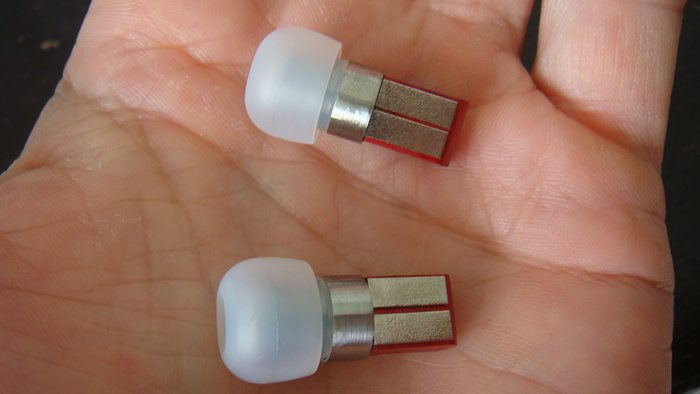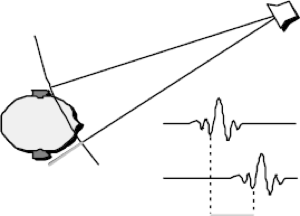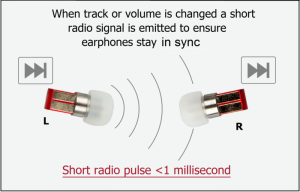 Split is a completely standalone music player in just a couple of earbuds. All of their claims are feasible on paper, but an aggressive schedule and no evidence that their form-factor prototype works as advertised raises doubts.
Split is a completely standalone music player in just a couple of earbuds. All of their claims are feasible on paper, but an aggressive schedule and no evidence that their form-factor prototype works as advertised raises doubts.
First, don’t think of these as next generation wireless headphones – Split cannot play music from an independent media player. Split is the media player, a real-world iPod Flea. The designers are targeting 4 hours of battery life and 256 MB of on-board storage at a $155 price point, which might be reasonable if the audio quality is high enough.
As for user interface, Split uses a 3-axis accelerometer for tap detection (or “bite detection” I guess), where single bites advance the track and double bites adjust the volume. Products have used accelerometer data for user interface purposes before, but the results so far have ranged from pretty okay to less-than reliable. In my experience, although several MEMS parts advertise hardware tap detection (e.g. ST Micro’s LIS3DH, Freescale Semiconductor’s MMA8653), their performance is questionable at the slower sampling rates one might like to use to conserve power. As a result, many designs choose to implement custom tap detection algorithms in firmware, which may account for the range in quality.
How does Split solve the problem? In short, we don’t know. We can only accept their assertion that a bite generates a “distinctive signature” and the very brief image of what is presumably some accelerometer data with a very clean, noiseless baseline.
It was about at this point that I realized that I’ve only seen two things about Split first-hand: (1) it uses a magnet to attach to the custom USB cable, and (2) that is looks good on a sexy girl.
Since these guys are asking for $435k overall with >$120k earmarked for additional hardware development, I’m inclined to believe they have significant work ahead of them. Their April 2014 delivery date may be excessively optimistic.
Anyway, to summarize: tap detection should be doable, but we shouldn’t take for granted that it will be done well.
Moving on. rather than streaming data between the two earbuds, which would surely destroy their power budget, each ‘bud maintains an independent copy of the music. Very clever (though it raises the question of how playback remains synchronized between the two ears). Of course, the designers try to spin this as a safety feature, claiming it’s healthier because there’s less “radiation” near your head. I understand the public perception of risk, and I understand these guys want to make money, but this seems like irresponsible marketing to me; the preponderance of evidence indicates no causative link between cell phone use and brain tumors in adults. I might expect this from a sales guy or your average person on the street, but the lead designer is an MIT-educated physicist who surely knows what good science looks like. I’m disappointed.
Meanwhile, more than 20% of the US population over 12 years of age is affected by hearing loss, so if we’re going the route of unscientific fear-mongering, maybe now’s a good time to bring up the potential link between personal music players and noise-induced hearing loss.
Getting back to keeping the two earbuds synchronized, let’s do some quick bar-napkin math: if Split uses a 1 ppm crystal as they claim, we should expect about 86 msec of clock drift per day or 55 μsec of drift per minute. In other words, if the two earbuds start a 3 minute long track perfectly synchronized, we can expect a 300 μsec timing difference at the end of the song in the worst case where one clock drifts 1 ppm fast, the other 1 ppm slow.
That doesn’t seem too bad, but what sort of timing differences can a human detect? Small ones, it turns out. Although the exact number depends on factors like frequency, volume, background noise level, humans can reliably detect interaural time differences in the 10s of μsec – it’s one of the auditory clues we use to calculate the source of a sound.
As a thought experiment, imagine somebody nearby claps their hands. If that person is directly in front of you, the sound will arrive at both ears simultaneously. However, if the person is 90° to your right, the sound will arrive at your right ear slightly before it arrives at your left ear. How slightly? If sound travels at 340 m/s at sea level and your ears are separated by 10 cm, the difference in arrival times is around 300 μsec.
 In other words, we should expect to perceive any drift between the two Split earbuds as a change in the music’s spatial location relative to our head. I wonder if the developers have measured the real-world drift between the two ‘buds or experienced this phenomenon first-hand.
In other words, we should expect to perceive any drift between the two Split earbuds as a change in the music’s spatial location relative to our head. I wonder if the developers have measured the real-world drift between the two ‘buds or experienced this phenomenon first-hand.
As for getting the two earbuds synchronized in the first place, the campaign is light on details:
 Good firmware running a well-designed radio protocol can ensure no latencies are introduced here, but no evidence is presented that indicates the designers have considered this challenge let alone addressed it.
Good firmware running a well-designed radio protocol can ensure no latencies are introduced here, but no evidence is presented that indicates the designers have considered this challenge let alone addressed it.
I want to like Split – I think it’s one of the few truly innovative products on Kickstarter that’s actually feasible – but I hesitate to endorse it without more information on the state of their prototype.





Leave a Reply